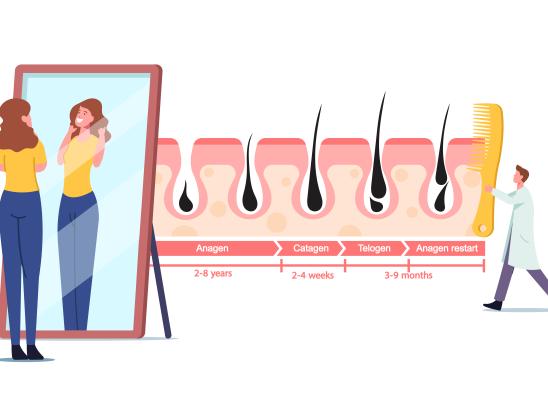CBT vs DBT vs ACT - Treatments for Trichotillomania

Online test
Find out the severity of your symptoms with this free online test

Trichotillomania is a medical condition that causes people to have the urge to pull out their hair. Patients, who suffer from it, suffer from the physical effects but also from the emotional effects that come with the disorder. The disorder is known to put a strain on people’s relationships as well as cause the sufferer to feel embarrassed and isolated. The causes of the disorder have yet to be identified. There are various ways of treating Trichotillomania with the main three approaches being cognitive behavioral therapy, dialectical behavior therapy and acceptance and commitment therapy.
What is CBT
Cognitive Behavioral Therapy (CBT) is focused around working with a mental health professional to learn coping strategies as well as change the way the mind thinks to lessen negative behaviors and increase positive ones. One works with a therapist to help identify how the patient perceives situations and once the therapist has an understanding they can help the patient work through those thoughts and come up with a more positive way of thinking about the situation. When the patient is able to change their thought pattern, then they will also change the behaviors associated with those thought patterns. CBT involves the patient setting short and long term goals in each session. In addition patients need to be an active participant in the sessions as well as be responsible for homework assignments outside of therapy. CBT has been one of the most successful approaches for treating Trichotillomania and is focused on Habit Reversal Training. HRT is based around the idea that the urge to pull out ones hair is triggered by certain stressors or events. Once the patient and therapist are able to identify the “triggers” they can work together to learn how to better cope in the situations and react in a different manner.
What is DBT?
Another treatment option is dialectical behavior therapy (DBT) is a form of CBT that is often used to treat people with suicidal thoughts or who engage in self-destructive behavior. The treatment plan is focused around the two ideas of acceptance and change. The idea is the patient must first recognize their thoughts that lead to the destructive behavior and then work to change those behaviors. DBT focuses the patient on improving in four categories. One of those categories is Emotion Regulation which is the process of recognizing emotions, labeling the emotion and then learning how to adjust to the emotion. The second focus is Distress Tolerance which focuses on the patient leaning to handle stressful situations without turning to destructive behavior. Mindfulness is the patient learning to be aware of not only themselves but the people around them. Finally Interpersonal effectiveness is learning to deal effectively with other people by learning new interpersonal skills. For Trichotillomania patients DBT therapy can be very effective. Through distress tolerance training, the patient will learn how to handle the stressful situations that cause them to pull their hair out. DBT also includes group sessions that can help patients improve their interpersonal skills. When patient are able to improve their personal skills the amount of situations that lead to stressful events are decreased.
What is ACT?
A third type of treatment program is the Acceptance and Commitment Therapy (ACT). The therapy program is based around the patient learning to accept the things they cannot control and making a personal commitment to engage in behavior that improves ones quality of life. The first part of the process is acceptance which involves the patient accepting ones negative thoughts and feelings and making room for them in one’s mind rather than trying to remove them which causes stress events. The therapy also uses techniques to help the patients distance themselves from negative thoughts , feelings and reactions by learning to live in the present moment without judgment. This is also commonly referred to as Mindfulness. Finally the patient commits to Values-based Living. The patient must identify the values and life goals that are truly important to them. The ideas is when patients have a strong understanding of their goals and values it will become easier to handle a stressful situations. Through ACT patients learn that despite the stress of the situation one can still make a decision that moves them closer to their goals. In ACT, Trichotillomania patients are taught to accept their pulling feelings and their urges. Instead of giving into the urge the patient must accept the urge and is taught how to work through it mentally. Patients are giving homework assignment and are asked to keep a “pulling urge” diary so that they can better understand their urges. Patients who suffer from this disorder often have low self-esteem due to the embarrassment it can cause. As part of the ACT program patient set goals that they want to achieve and as they move closer to reaching those goals their self-esteem will start to improve.

These three approaches have all been shown to be successful with patients. If you are a sufferer you should talk to your mental health professional about these options and decide if one of these will work well for you. A mental health provider can also customize an approach that involves a combination of these treatments. These treatment programs are not one day fixes so make sure the doctor you speak with makes you feel comfortable and it is someone you can envision working with for week to come.
It is important to remember, that there is help available to you and if you are willing to commit to a program you will start seeing the results of your hard work.
Source
http://www.mentalhealthamerica.net/conditions/trichotillomania-hair-pulling
Online test
Find out the severity of your symptoms with this free online test
Start your journey with TrichStop
Take control of your life and find freedom from hair pulling through professional therapy and evidence-based behavioral techniques.
Start Now



